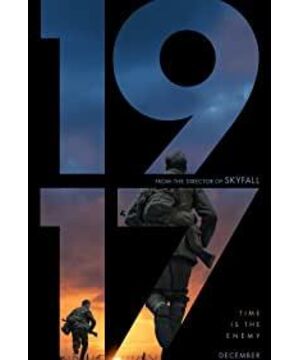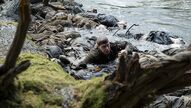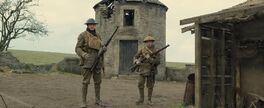I watched the IMAX version of "1917" in January, and lamented the technical miracle of immersive one-shot in the whole film. I also regret that as one of the few war films that can dabble in the theme of World War I, this film gave me an impression. More is the gimmick that wants to play with technology. Although this movie deliberately wants to create a true reaction of all living beings in the face of the cruelty of war, it is compared to many movies of the same themes, especially the hallowed gods such as "Road to Glory" and "Merry Christmas". As for the work, the film still appears shallow in the portrayal of the characters and the depth of the ideological core. Moreover, because the prototype of the story is loosely based on the director’s grandfather's experience of participating in the war in his childhood, in order to extend a simple letter-delivery story to the ups and downs of life and death tests, the middle part of the movie adjusts the rhythm of the bridge ( The strong sense of drama (such as a plane crashing into a barn) will inadvertently deprive the immersive atmosphere created before, and also lose part of the heavy feeling that this film wants to create, which can be said to be a pity. However, speaking of the shortcomings of the plot, the movie itself is absolutely outstanding in the tragic visual effects of the trenches and no man's land in World War I. The director also made full use of the two-hour journey to present the various keywords of the First World War battlefield to the audience with scenes of extremely visual impact. I will try my best to split the scenes in the film one by one and introduce them to everyone. Behind these keywords is the tragic history of the First World War.
story background:
The film took place on April 6, 1917. On this day in the movie, the German army carried out a tactical retreat in an attempt to lure the enemy into strangling the British army that followed. The main character’s mission as a messenger was cut off on the telephone line. In this case, the superior’s order to cancel the offensive was communicated to the Second Devonshire Battalion on the other side of the front, which was preparing to attack, otherwise 1,600 people would be killed under German artillery.
Historically, the war on the Western Front in Europe in 1917 was still stalemate, and the Russian Empire on the Eastern Front gradually fell apart under the vigorous Bolshevik Revolution. Therefore, as the pressure on the Eastern Front was reduced, it was also recognized that Germany was unable to endure the same as the 1916 claim. After the tragic loss of the Battle of the Muhammad, Kaiser Wilhelm II decided to retreat the French front-line troops to the stronger Hindenburg line built by the Germans to optimize the allocation of resources and the preparation of troops, and at the same time restarted. The strategy of unrestricted submarine warfare was an attempt to win the victory by killing Britain by blocking sea supplies. The strategic retreat code-named "Aiberich" (Aiberich) started from February to April. The German army took advantage of the darkness to remove 10-14 divisions from the Battle of the Somme in 2 months. Afterwards, the occupied area protruding between Arras and St Quentin was evacuated to the Hindenburg Line, retreating the German front by 40 kilometers.
During the evacuation period, in order to ensure that the advancing British and French forces would not take advantage, the German army adopted a scorched earth policy. It took a week to cut down all the fruit trees in the occupied area, pollute the wells, razed villages to the ground, and blocked roads with trees. And blow up all the railways and bridges. Approximately 125,000 young civilians living in the occupied area were transported to work in France and other areas of Belgium, while children, women and elderly people with disabilities were left by the German army, and only a few rations were given to survive on the battlefield. In the abandoned trenches at the forefront, the German army installed a large number of trip mines and booby traps. On the way back, the German army also planted sporadic snipers and defensive troops, posing a huge threat to the rushing British and French soldiers.
The various scenes in the movie are very reminiscent of this period of history. The trip thunder in the German tunnel, the artillery blown up during the retreat, the felled orchard, the road blocked by the trees, the blown up bridge, the German sniper in the building, and The French women and babies hiding in the basement of the village (the name of this village is Écoust-Saint-Mein, Écoust-Saint-Mein, a village located in the very center of the occupied area), these are the most true of this history Portrayal of.
Due to the scale of the German retreat and the secret whereabouts, the commander of the British and French coalition forces was very confused when faced with such an "empty city plan", which also seriously disrupted the attack plan of the two armies originally scheduled for the spring, and the trap set by the Germans on the way forward And obstacles also severely hindered the confidence of the British and French armies to advance, and the movie was also inspired by this historical event. Against the background of the German retreat, it created a dangerous journey of fearful steps and hidden crises.
There is also an interesting historical fact that the film took place on the day when the United States entered the war in World War I. I won’t discuss the reasons why the United States entered the war here, but the point is that the Americans are on the surface to defend freedom and democracy, but in fact they are just afraid. Britain and France could not afford the bonds they bought from the United States during the war.
The messenger-a race against time:
In the film, the protagonist Scott Field and Corporal Black are the Runners delivering letters between the British army and the troops. During the First World War, it can be said that the era of the explosion of modern technology, tanks, airplanes, new firearms, medical technology and other technologies. Both have been greatly improved in the war. However, the communication technology during this period has not made much progress. The most mature telephone line technology often fails under the enemy's artillery fire and destruction in the complex battlefield environment. The newly developed radio is not only poor in confidentiality, but also limited in use. Therefore, most of the time, the method of "communication relies on roaring, and transmission relies on leaving" is still used to convey information. This also highlights the advantage of the messenger: it is more reliable than a statically connected telephone line. As a carrier of information, people can not only remember more complex information and avoid the destruction of the files they carry, but also destroy information at critical moments to prevent interception by the enemy. Most importantly, the flexibility of the messenger ensures that the information is delivered to the battlefield. Dangerous, the most difficult-to-reach corner. It is precisely because of this that the messenger who regularly shuttles between the front lines and no man's land can be said to be the most dangerous occupation in the First World War except for the assault team.
Messengers are usually selected based on their physical fitness, endurance, and ability to read maps. Most of the messengers are handled by small people. The military has very high requirements on the thinking and psychological quality of the messenger. It must be able to find a destination in any weather environment, and it must have sufficient legs and feet to survive the rain of bullets and bullets. And because of the great danger carried by the profession itself, the messenger is usually taken by an excellent soldier with a lower rank. The protagonist in the film, Scott Field, is a corporal who survived the Battle of the Somme and was able to fight in that battle. There are only a handful of surviving soldiers, which also proves that he is sufficient for such an important mission. What’s interesting is that Adolf Hitler, the leader of Nazi Germany, also served as a German messenger during World War I, and was still injured in the course of his mission. He was wounded by shrapnel, and was burned by the mustard gas of the British Army in 1918, and almost lost his eyesight.)
As described in the film, the messenger is usually a group of two or more to deliver information. American Sergeant Alexander McClintock, who served in the Canadian Forces in France, described the establishment of front-line messengers in a newspaper in 1918: “Generally speaking, two or three messengers are dispatched at the same time or Sending three messengers according to different routes is the basic principle of forwarding information, so that at least one person can surely deliver the information to the destination." At the same time, he also described the terrible consequences of not following the rules: "There was once Once, before a force was about to launch an attack on a German position, an officer changed the offensive plan at the last minute and only sent a messenger to convey the message. As a result, the messenger was killed by the Germans while crossing no man’s land. , His news was not communicated. As a result, a battalion attacked the Germans without fire cover, causing more than 600 casualties within a few minutes. Due to this terrible mistake, several officers were sent on board. Military court.” The story of "1917" was also inspired by this story to a large extent, which is why in the film Scolfield would fight his life to transmit the message, because if the thin piece of paper in his hand didn’t If it is delivered to the front line in time, then thousands of lives will be sacrificed in vain.
Also as described in the film, apart from the gunfire and bullets on the opposite side, the messenger's other biggest enemy is disorientation. The battlefields of World War I were jagged and complex, and the frontline situation was even more unpredictable. Lacking the current GPS, satellite maps, and radio guidance, the messengers of World War I can only rely on a map that may be outdated, the guidance of the local defenders who have been stationed for a long time, and their own intuition to find their way. And most of the time, in order to avoid bullets, most of the messengers choose to set off at night, which is why the protagonist will be worried about the decision to set off during the day when he takes over the mission. After all, if there is a sniper, crossing the battlefield will definitely be a dead end.
Losing their way in the dark night with fingers out of sight is even more commonplace. Most of the messengers were captured and even died at gunpoint because they often walked into the enemy's occupied areas because they lost their way. The film’s description of the danger of the messenger getting lost in World War I is very wonderful. That part of the night when Skefield strayed into the German occupation area and escaped the German army in a French village. It can be said that the scene is one of the most thrilling experiences on the screen in the past ten years. I believe that in reality, there are absolutely countless more dangerous situations than this.
There are also many messengers who have escaped danger by virtue of their dexterity. At the beginning of the war, the British messenger named George Fletcher ran into a German patrol while riding a motorcycle on the front line at night, but luckily because he was an Eton school. The German teacher used his standard accent to make the patrol team mistakenly believe that he was an officer and escaped.
Of course, only in emergency situations will the messenger need to work so hard. Not all messengers are so hard pressed, most of the time messengers will use horses, bicycles or motorcycles to send messages between battlefields. In addition to letters, there are many other ways to send messages, such as signal lights and flare (also reflected in the film). The troops on the battlefield of World War I even made their soldiers wear marked sheets or put them on their backs when they charge. Paste stained glass to make it easier to distinguish foe and foe. In addition, in addition to humans, good friends of mankind: dogs and carrier pigeons also assume the role of information transmitters on the battlefield.
Trench life: trench warfare, no man's land and disease
Whenever we mention World War I, the first impression that comes to mind is the endless trenches and the soldiers huddled in the trenches. Although this movie doesn’t focus much on the trenches, the most famous visual element of World War I, through a few fragments and the few words in the dialogue between the two protagonists, the audience in front of the screen can still feel the hell-like life in the trenches a hundred years ago. .
Let me briefly talk about the causes of trench warfare: The reason why World War I fell into the stalemate of trench warfare is, in short, caused by the inequality between backward military thinking and advances in military technology. At the beginning of the First World War, the tactical thinking of the several warring empires was still the outdated idea of relying on infantry and cavalry to quickly encircle and annihilate during the Franco-Prussian War in the 19th century. Little did they know that with the outbreak of the first industrial revolution, war was no longer what it used to be. This is a game in which nobles line up to shoot each other (this is a bit exaggerated, after all, in the middle of the 19th century, the skirmish array has replaced the lined array for shooting, but the general idea is to let the infantry rush forward with guns). With the Maxine water-cooled machine gun with a rate of fire of up to 600 rounds per minute, the bolt-action rifle loaded with magazines, the more powerful, faster, and more accurate retreating field guns are on the stage of war. These killing tools The high efficiency allows the defender on the battlefield to have more relative advantages, and the offensive who lacks effective maneuverability have no choice but to let their soldiers run forward on two legs if they want to seize the enemy’s position. In addition, most of the wars took place in the rural areas of France with relatively flat terrain and broad vision. It is conceivable that a group of soldiers and cavalry, without any cover, faced the enemy's machine guns and shelling on the endless grass and fields. Charge in batches, and then fall into the blood sea of Shishan in batches. This kind of despair is unmatched by any future war.
Because of this, a few months before the start of the First World War, the casualties on both sides reached an astonishing hundreds of thousands. It is only a matter of time before the country is destroyed and the species are destroyed at this casualty rate. Therefore, realizing that the frontal attack would only waste manpower in vain, both sides began to dig deep trenches to consolidate their defenses. The short temporary trenches on the front line gradually became complex and wide-area fortifications to resist enemy fire. Therefore, after experiencing massive casualties, the front line established at the beginning of the war has not undergone much change for four years. Most of the time the war was dominated by low-density military friction, although the two sides had several attempts to break through each other's defenses in four years, such as the Battle of Marne in 1914, Verdun in 1916, the Battle of Somme, and 1917. The Battle of Pashandale in Nivelles in 1984, but these battles often made little progress on the front, and only advanced a few kilometers at the expense of tens of thousands of lives. For most of the four years, the war proceeded as a static stalemate in the trenches of both sides.
Under such a general environment, trench warfare was born. Let me first introduce the basic composition of trenches: the trenches of World War I usually consist of a series of two, three, four or more trenches extending parallel to each other and at least 1.6 kilometers long. Line composition. The frontline trenches usually only have a small number of guards, and they enter the trenches for defensive tasks only in the early morning and evening. The second is the support trench. The current trench is shelled and the troops will withdraw here. The third is the preparation trenches. There is another unit in it. If the frontline trenches are taken down, this unit can try to counterattack.
In order to ensure the survival of the infantry in the trenches under artillery fire, the British trenches are curved and extended, while the German trenches are dug in a zigzag shape. In this way, fragments of shells falling into the trenches will be blocked by the curved trenches, and the impact will be reduced. Will not harm nearby soldiers to reduce casualties. The curved trench also ensures that if an enemy enters from the side, the troops will not be exposed to enemy fire all at once. The visual characteristics of the trenches of the two armies are also reflected in the movie. The trenches of the British army are winding sandbag paths, and the trenches of the German army are square concrete shelters. The movie also restores a historical detail, that is, the German bunkers are generally deeper than the British military. Compared with the British trenches, which are about 2 meters deep, some of the German trenches are even three floors deep. This ensures that the trenches can provide defense for a large number of defensive forces when the enemy's artillery attacks.
Each main trench is interconnected by a series of vertical communication trenches and connected to the rear command. Food, ammunition, recruits, mail, and orders on the front lines are delivered through these communication trenches. A complex network of trenches includes frontline command posts, supply stations, post offices, first aid stations, kitchens and toilets. Trenches located on the front line usually have stronger fortifications, observation posts and machine gun firepower points to prevent surprise attacks by the enemy.
Because of the long stalemate and continuous shelling between the two sides, the empty area between the trenches of the two warring parties gradually formed a "No Man's Land"-a death zone not controlled by any forces. On the Western Front, Some no-man’s land is one kilometer wide, and in some areas with fierce fighting, the no-man’s land is even more than ten meters wide, so close that the two sides can throw grenades into each other’s trenches, and even verbal abuse can be heard.
No Man’s Land is the most representative visual element of World War I, and it is a part that will not be absent from any World War I movie. This piece of land that separates the two forces has been covered by bullet craters, poison gas, barbed wire, corpses, and death during the four-year war. "The muddy land is full of dead animals, dead humans, barbed wire and There is almost no vegetation in the crater." The dense sniper and machine gun firepower network deployed by the two sides completely blocked all attempts to directly pass through the no-man’s land, and every attempt to break through this land of death would often only add a few hundred in the no-man’s land. The recovered corpses were either buried in the soil or hung on a wire fence, letting the wind blow and rain, and slowly decayed. Finally, the bones, gunpowder, and shrapnel melted into the mud under the feet. Become the embellishment of this scene of death.
With long-term shelling and humid climate, the craters in the no-man’s land on the Western Front are often covered by mud mixed with corpses in summer and autumn. Fear is far less intense than mud. If anyone accidentally steps into the mud, there is basically no possibility of crawling out of the mud alive. The thick mud will slowly drag the soldier down until it passes his head. During the Battle of Passchendaele in 1917, this Belgian town suffered a summer torrential rain. The already soft ground was bombarded by more than 4 million artillery shells. Passchendaele became a dirty and stinky one. A huge quagmire. It takes about 6 hours or more to move a cannon to barely advance 250 meters. The carriage staggered through the quagmire with the wounded. Many people fell from the carriage due to the bumps of the road and were choked to death in the thick mud. It is worth noting that the thick mud caused many rifles and artillery shells to misfire during the battle, and more people were swallowed up by the mud and disappeared.
This muddy battle became the cruelest battle in the First World War. Commanders would even cry in public for the terrifying experience of their soldiers. A British engineer wrote about the conditions of the battlefield: “There is no ground to walk on. The artillery shells have ploughed the land again and again, leaving nothing solid. Only a piece of loose, fragmented, and distant land remains. In the turbid, unpredictable mud and water, criss-crossing craters were formed, and only the largest, recently dropped shells would form a round shape that could be barely discerned...In 48 hours, they were caught. Mud covered, cold skin, stiff limbs, the danger they face and the fear caused by the falling comrades around them numbs their nerves. They live by shaky discipline, not the spark of life. Some cowardly people and (Thinking) People at higher levels even deliberately self-destruct." Purgatory in the world is nothing more than that. The description of the corpses in the no-man’s land mixed with mud in the film also accurately restores the muddy suffocation of this dead zone, which makes people shudder.
The desolation of no man's land has also created some distinctive road signs in a sense. Soldiers on the front will also observe the topography of the battlefield through the periscope, and provide landmarks to point out the direction of the troops or messengers like the protagonist. The opposite is also reflected in the movie: the commander of the frontline trenches uses a dead horse, a corpse on a wire fence and several craters as landmarks to guide the protagonist.
Only when night falls, will there be a little anger in the no-man’s land. Through the darkness, the soldiers on both sides would creep out of the trenches and crawl toward the depths of the no-man’s land. They are either responsible for detecting the enemy's movements, or repairing the barbed wire while destroying the opponent's barbed wire to create a surprise route for the friendly forces. The night is also the only chance to rescue the wounded soldiers trapped in no man's land. This is why the commander in the trenches will advise the protagonists if they are injured, they can only drag them back at night. But in many cases, the darkness cannot guarantee absolute safety. The flares fired into the air from time to time will instantly expose everyone who is active in the no-man’s land to the threat of the muzzle again. Scofield’s escape in the night is a re-enactment of this history.
The cruel and terrifying legacy of no man’s land still poisons the land of Europe. A fact that many people have not heard of is that France is one of the few countries in the world where no man’s land still exists. Located near Verdun in central France, the "red zone" of about 460 square miles was the most intense and bloody area during the Western Front of World War I, because there were a lot of unexploded ordnance and chemical components leaked from gas bombs in the soil. Even in the past hundred years, this land is still deadly and dangerous. The red area shown in the picture has not been opened to the public due to danger until today, and hundreds of tons of unexploded ordnance can be cleared out of the red area every year. According to official estimates, it will take 300-700 years for this piece of land to recover. This shows the destructive power of the First World War on human society and the terror of the natural environment.
As mentioned earlier, because it is tantamount to commit suicide by climbing out of the trench at will to charge in no man’s land, the feature of trench warfare is to use the extension of the trench to shorten the distance between the two sides’ no man’s land, so that the troops can quickly maneuver into the opponent’s trench to carry out a surprise attack. . Therefore, in the absence of large-scale battles, the front lines of the battlefield most of the time were digging new temporary trenches in the direction of the enemy, and carrying out surprise attacks after shortening the distance. This group of soldiers is also known as the assault troops "Strom Trooper" ( Or Trench Raider). For their video data, you can refer to the World War I documentary "They Will Not Grow Old".
When the terrain permits, the two sides will even dig tunnels under the enemy's trenches, and then bury explosives to blow up the opponent's trenches. This tactic is used in large-scale battles such as the Somme. It is quite common for both sides to dig trenches and even tunnels on the front line. Because the time in the film is during the German retreat, there is not much detailed description of the trench warfare. More details will not be written here. I have time to introduce it in more detail in the future.
After briefly talking about trench warfare, let’s talk about the life of a soldier in a trench warfare. Unlike many people imagine, a soldier needs to spend a long time in the trenches on the front line. Generally speaking, a soldier stays in the trenches on the front line for a short time. In each rotation, they will spend about one day to two weeks in the frontline trenches, and then return to the rear for repairs and vacations. During the entire service period, soldiers only spend about half of their time on the battlefield, and less than 20% of their time on the frontline to prepare for battle. This may be unexpected, but the reality is that these short two weeks are enough for soldiers to leave a lifelong nightmare journey. The first threat is the bombardment that occurs on average every five days. When the two sides are unable to advance, they can only use artillery to destroy each other's positions and active forces at a long distance. Although shelling seldom hits people, the loud noise and frontline psychological pressure are enough to drive a sane person crazy. The impact and vibration brought by artillery can even destroy the soldier’s nervous system, psychologically and physically. Completely defeat a person. During the war, many frontline troops reported that more and more soldiers on the frontline had psychological problems without being injured, such as uncontrolled shaking, tinnitus, forgetfulness, headaches and other health conditions. They were later diagnosed as "bouncing shock". "(Shell Shock Syndrome) is a psychological trauma closely related to post-traumatic stress disorder (PTSD). At the end of the movie, when the protagonist is looking for a commander in the Devonshire Legion, a captain crying tremblingly before the charge, it is obvious that he is a victim of bullet shock.
In addition to worrying about the shells falling on their heads, the soldiers in the frontline trenches are more worried about the health problems caused by the harsh weather and environment. Due to the tragic frontline, most of the remains on the battlefield were not cleaned up and could only slowly decay. The rotting corpses breed a large number of bacteria. Poor sanitary conditions provide a breeding ground for rat and lice to spread plagues and diseases. Common diseases include dysentery, typhus and cholera. Many soldiers have suffered from parasites and plague. Poor sanitary conditions have also made the trenches full of fungi, and skin erosions caused by fungi are even more commonplace. In the film, when the protagonists enter the bunker where the German army rests, the audience has the opportunity to see the real faces of the trench rats and feel their terrifying body. After they passed through the trenches abandoned by the Germans, Black mentioned the story of a comrade of his comrade who had his ears eaten by rats at night because of the good-smelling hairspray. Such stories were commonplace during the First World War.
As mentioned before, because the corpses on the battlefield are rarely cleaned up, rain and new trenches have re-planed the dead corpses buried in the soil to the surface. The abundant food sources have triggered an explosive growth of rats. Many World War I books and memoirs have rich descriptions of the number and size of mice, even more creepy than movies:
"The rats came from across the strait and fed on a large number of corpses. They reproduced very diversely. A new officer had just arrived on the front line. When he turned to sleep that night, he heard a harsh sound from the bed, and he lit it with a torch. On the head of the bed, two mice were found on his blanket, fighting for a broken arm."
"There is no waste disposal mechanism in the trenches, and all kinds of empty cans are thrown on the sides above the trenches. Therefore, there are millions of cans on the trenches that stretch for hundreds of miles for all the rats in France and Belgium to enjoy. In the short quiet moments of the night, people can hear a series of tin cans rattling, that is, rats are looking for food in these cans."
"The mice are big, like cats. They are too big. If a wounded soldier loses the ability to protect himself, these mice will eat him alive."
"These rats have become very bold. They will try to steal food from sleeping people's pockets. Two or three rats will always be found on the corpse. They usually eat their eyes first, then go into the corpse and eat the rest. The part.""
A soldier described a group of corpses found during patrol: "I saw some mice squirming under the coat of the deceased, huge mice with human fat hanging from their mouths. When we walked to one of the corpses, my My heart jumped nervously: I saw his helmet rolled over, revealing a wrinkled skull with little flesh, swallowed eyes, and a mouse jumped out of the skull's mouth.
Historically, in order to eliminate these mice, the two sides of the war did their best to kill the mice with hounds or even flamethrowers. The picture below is the result of the German-trained hounds in the trenches.
In such a harsh environment, if you are injured on the front line, without timely treatment, it is equivalent to having stepped into the ghost gate with one foot. Antibiotics that were effective against bacterial infections had not yet been discovered, and even skin injuries on the front lines could become fatal due to infections and gangrene. In the German army, the mortality rate for leg injuries and arm injuries was 12% and 23%, respectively. 44% of the wounded in the U.S. military died of gangrene. Of the soldiers injured in the abdomen, only 1% survived. On the front lines lacking drugs, most of the wounded with hand and foot injuries can only be amputated, otherwise, the infection spread to the whole body will kill the injured in a short time.
This situation is more serious in summer and winter. In summer, the humid and rainy climate in northern France often brings heavy rains to the war zone. In the summer sun, bones rotting and soil mixed with other bacteria are carried into the trenches by rain. , So that the sanitary environment, which is not optimistic, is even worse. In addition to sleeping in the corpse remains of one's comrades in the cold night, feet that have been soaked in rain for a long time will be severely infected by fungi and cause "trench feet", a tissue damage that can cause foot necrosis. The soldiers wounded during this period, because of the increase in bacteria, died in nine deaths. In winter, in cold weather and lack of warm clothing, some soldiers will be frozen to death on the front lines if they cannot even survive the change of guard. Therefore, living in such an environment, sacrifice on the battlefield is regarded by many people as a blessing. It is better to die than to live. Living in such a purgatory environment, surrounded by corpses, mosquitoes, rats, and rotting stench, In contrast, taking a gun can be said to be very kind.
The following are the top 20 injuries in World War I calculated by the researchers. It can be seen that gunshot wounds on the general battlefield are not the main source of injuries.
Trench fever (8.7%)
Inflammation of connective tissue (7.9%)
Trench foot (6.8%)
Cold (6.6%)
Scabies (6.1%)
Shrapnel (4.9%)
Gunshot wounds (4.7%)
Mustard gas and chlorine gas poisoning (3.98%)
Diarrhea (3.0%)
Rheumatism (2.6%)
Bullet shock (2.3%)
Gonorrhea (2.2%)
Lung infection (2.1%)
Syphilis (2.0%)
Femoral fracture (1.9%)
Urinary tract infection (1.8%)
Lice (1.8%)
Other STDs (1.6%)
Gangrene (1.3%)
Wasp sting (1%)
Because the film took place in April when the weather was relatively pleasant, the film did not show much of the poor sanitary conditions on the battlefield, but it still used the palm of the hand being scratched by the barbed wire when passing through the no man’s land, and the injured hand fell into it again. The side of this bridge in the decomposing corpse reflects the reality of sanitation.
summary:
This film is not so much a thought-provoking anti-war masterpiece, as it is a dazzling film for the best photography. All of the dramatic passages and the interpretation of the bad vulgarity of "British-French Friendship" made this movie lose a lot of points in the plot. But it is undeniable that this film is a very restorative depiction of the battlefield of World War I. I also hope that after the epidemic is over, this film will be released as scheduled, to popularize the forgotten history of a hundred years ago for domestic audiences. I will write so much about the background science of this film. If you are interested, I can talk about the British Foreign Corps and other historical backgrounds of World War I. The tragedy of World War I, as Colonel McKinsey played by Cumberbatch at the end of the film, said: “Now retreat, and next week will send a different order to attack at dawn. There is only one way to end this war, and that is to fight to the last one. People." In the senseless seesaw back and forth, thousands of young lives were swallowed by the ambitions of the nobles, and the desperate charges were repeated human tragedies. May the world be peaceful and hope that everyone can survive the epidemic safely.
View more about 1917 reviews











